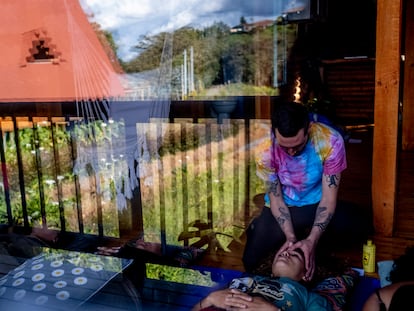Sonoran desert toad secretions may have therapeutic uses, says Mexican psychologist
Ana María Ortiz is researching treatments for depression and anxiety using the psychedelic toxins of a rare amphibian

The Sonoran desert toad releases defensive secretions from its skin that contain 5-MeO-DMT, a powerful hallucinogenic that is attracting attention beyond the borderlands of northern Mexico and the southwestern United States. Any mention of the Bufo alvarius toad generally conjures up thoughts of mystical hallucinations, scientific hypotheses, therapeutic potential and even death by poisoning. Mexican psychologist Ana María Ortiz has been researching 5-MeO-DMT for years at the University of Wisconsin’s Transdisciplinary Center for Research in Psychoactive Substances. Next year she will begin controlled studies to understand the true benefits of a compound that many people say changed their lives.
Question. The Sonoran desert toad’s hallucinogenic secretions are becoming increasingly famous around the world, just like the hallucinogenic plants ayahuasca and yagé. Why all the excitement?
Answer. This toad has a very different history from the two plants you mentioned. They have been used in Colombia and Peru for hundreds of years in spiritual rituals. Very few people in Arizona and Sonora (Mexico) knew about this toad until Albert Most published his famous pamphlet and inspired other researchers to begin experimenting with it. Anthropologist Wade Davis and Andrew T. Weil, a doctor of integrative medicine, published a couple of articles with their theories about the toad and its psychedelic substance. Dr. Weil even went looking for a mysterious man named “White Dog” who claimed to know all about the toad. People started consuming the psychedelic toxin in the mid-1980s, and it became quite popular about 10 years ago.
Q. Are you suggesting that this aura of ancestral tradition is a fabrication?
A. Ten years ago, a group of people in Mexico began approaching the indigenous peoples of Sonora about this toad. They first went to the Seri people and deliberately spread a false narrative that the Seri had an ancestral tradition of using toad secretions that was lost during the colonial period. Unfortunately, indigenous groups in Mexico live in extreme poverty with no health care or other social services, so when they saw that the toad could become a source of income and tourism, they began using it.
Q. Why did scientists become interested in the Sonoran desert toad secretions?
A. A group of researchers led by Alan Davis started doing research in 2018. They designed an epidemiological survey and published several studies. Davis’s team found that 80% of the survey participants reported improvements in their depression and anxiety [from consuming hallucinogens]. They didn’t set out to treat these conditions – it just happened. There is an urgent need to find efficient mental health treatments. Antidepressants do work, but they have limitations. In 2006, the first rigorous research began on psilocybin, a psychedelic found in certain mushrooms. The study data suggested that just a few doses of the substance had short- and long-term therapeutic impacts, which challenged the paradigm of long-term treatment with antidepressants, perhaps even for life.
Q. What did scientists find so appealing about 5-MeO-DMT? Why did they start researching this substance when there was so much proven research on psilocybin mushrooms?
A. Psilocybin and MDMA treatments are already well on their way to obtaining approval from the US Food and Drug Administration (FDA). But administering those substances requires two psychologists in attendance during an eight-hour session, plus pre-session preparation and post-session reintegration time. The speed and effectiveness of 5-MeO-DMT is what appealed to many scientists and entrepreneurs. If it can have a months-long positive impact on the mental health of people who were not even seeking treatment, imagine the therapeutic effect it could have within a protocol for treating substance abuse or post-traumatic stress disorder.

Q. Specifically, what are the objectives of that research?
A. One of the most interesting aspects of psychedelics is that they are challenging the established system of treating everything with drugs – take this drug for depression, this one for anxiety and this one for an eating disorder. When scientists see that psychedelics could work for all of these conditions, they start thinking about whether there should be a global transdiagnostic mechanism for patients with mental health problems. But some people fear that science will erase the mystical potential of natural and traditional medicines.
Q. For therapeutic purposes, how relevant is the mystical experience of the users?
A. Very important. Davis developed a “Psychological Insight Questionnaire,” which measures the extent to which people perceive that their experience with a psychedelic resulted in new insights about themselves or about a troubling situation. In fact, my own research is looking at the relationship between the intensity of the 5-MeO-DMT experience and its effect on people’s feelings of connection with nature, their tendency toward prosocial behaviors and psychological flexibility.
Q. These are still banned substances with negative stigmas. Will science pave the way for legalization?
A. Colleagues of mine in Mexico are drafting legal reforms for this because just like in the US, all sacred plants and psychedelics are currently classified as category 1 substances, which are highly addictive substances without any therapeutic value. This isn’t true! Others in Mexico are advocating for ayahuasca, peyote and mescaline to be reclassified as category 4. But some experts say that won’t work very well because the drug classification system isn’t relevant to these kinds of substances. They want a new regulatory body that controls their use but also protects indigenous traditions, especially the ritual use of psilocybin.
Q. It’s still illegal in the United States.
A. Yes, that’s why all the research with 5-MeO-DMT has so far been limited to surveys. My research over the past few years has used a survey very similar to the one that Dr. Davis developed. I’m about to start the data analysis stage. But it’s not a controlled study. Since there is now so much evidence that these substances work, the US government recently awarded a grant to Johns Hopkins University for the study of psychedelic treatments on a larger scale.
Q. Is there a difference between synthetic 5-MeO-DMT and the compound extracted from the toad?
A. Both are equally effective. Toad secretions have other substances like cardiac glycosides that can kill you when consumed orally. There is a lot of misinformation about toad secretions out there – some say you can inhale or smoke it. No! The only way the secretion can be used safely is by vaporizing it first because the heat evaporates all the undesirable substances. The synthetic compound, on the other hand, can be administered in several ways: sublingual, inhalation by nose, and perhaps an intramuscular injection, which is still being studied. Instead of the dramatic, 20-minute, near-death experience described by many people who have consumed the toad secretion, the synthetic compound provides an equally profound but smoother, hour-long experience. It lends itself well to the development of a whole new model of effective mental health treatment.
Q. What risks do you see in the proliferation of ceremonies using hallucinogenics?
A. Psychedelics are not addictive, but people have reported a “reactivation” phenomenon in which the effects of 5-MeO-DMT are re-experienced days, weeks, months or even years after consuming the substance. These reactivation experiences can be mystical and very pleasant, but can also produce anxiety and disrupt sleep if they become recurrent. Psychedelics also raise your blood pressure, so scientific studies always select suitable participants. But in the toad world, you’re suitable if you have money. The people facilitating these ceremonies don’t have any protocols. They don’t check for persistent cardiovascular conditions or any family history of mental health problems or psychotic breaks.
Q. Has the population of the Sonoran desert toad been affected by all the secretion extraction activity?
A. You’re already at a disadvantage when dealing with an endemic species because they require very special environments to survive. Because of the false narrative of ancestral traditions, the extraction of toad secretions has escalated to an unprecedented level. The preliminary results of our population studies show that five or 10 years ago, places with healthy populations of large, medium and small toads now only have very few small toads. The big ones are gone – they’ve all been taken!
Sign up for our weekly newsletter to get more English-language news coverage from EL PAÍS USA Edition
Tu suscripción se está usando en otro dispositivo
¿Quieres añadir otro usuario a tu suscripción?
Si continúas leyendo en este dispositivo, no se podrá leer en el otro.
FlechaTu suscripción se está usando en otro dispositivo y solo puedes acceder a EL PAÍS desde un dispositivo a la vez.
Si quieres compartir tu cuenta, cambia tu suscripción a la modalidad Premium, así podrás añadir otro usuario. Cada uno accederá con su propia cuenta de email, lo que os permitirá personalizar vuestra experiencia en EL PAÍS.
¿Tienes una suscripción de empresa? Accede aquí para contratar más cuentas.
En el caso de no saber quién está usando tu cuenta, te recomendamos cambiar tu contraseña aquí.
Si decides continuar compartiendo tu cuenta, este mensaje se mostrará en tu dispositivo y en el de la otra persona que está usando tu cuenta de forma indefinida, afectando a tu experiencia de lectura. Puedes consultar aquí los términos y condiciones de la suscripción digital.
More information
Archived In
Últimas noticias
Maduro pleads not guilty before the federal court in New York: ‘I am still the president of Venezuela’
A new test can detect Alzheimer’s from a finger prick
UN team enters Sudanese city of El Fasher after paramilitary massacre: ‘It’s like a ghost town’
A recipe for resistance: Indigenous peoples politicize their struggles from the kitchen
Most viewed
- Gilles Lipovetsky: ‘If you want to live better and fall in love, take Prozac, don’t look to philosophy’
- Alain Aspect, Nobel laureate in physics: ‘Einstein was so smart that he would have had to recognize quantum entanglement’
- Alvin Hellerstein, a 92-year-old judge appointed by Bill Clinton, to preside over Maduro’s trial in New York
- Maduro’s downfall puts China’s relationship with Venezuela to the test
- Why oil has been at the center of Venezuela-US conflicts for decades










































